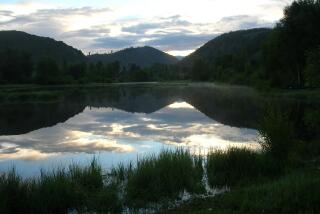Friendship Flight : Tony Circles the Globe : Along Tony’s Way, There Are Always the Children
- Share via
MAGADAN, Soviet Union — After landing in this Soviet Far East outpost, an ocean away from home, 11-year-old Tony Aliengena did not even have to look out his cockpit to see who was awaiting his arrival.
Sure enough, there they were: scores of smiling young children clad in the trademark orange neckerchiefs symbolizing membership in the Young Pioneers, the Communist Party youth organization.
Since entering the Soviet Union June 23, the San Juan Capistrano aviator and his entourage have been met every step of the way by the Young Pioneers. Leningrad, one of the first stops on Tony’s itinerary, featured a tour of a so-called Pioneer Palace where children go to study and make handicrafts.
In Moscow, Tony was shuttled to the headquarters of Pioneer Pravda, a youth newspaper that circulates to about 11 million Pioneers.
Rallies at Each Stop
And, in all but one of his nine stops since Moscow, Tony’s hosts have whisked him out to one of the local Pioneer camps where children spend the summer. Sunday night in the eastern Siberian capital of Yakutsk, Tony and his family were given center-stage seats in the local Pioneer Palace for a children’s production that included a play and a group of Bulgarian dancers.
The Pioneer children have been rallied out at each stop by local representatives of Komsomol, the youth arm of the Communist Party Central Committee. Komsomol has been in charge of all Soviet travel arrangements for Tony and his family.
Although Tony has never seemed to tire of all the adulation by his Russian-speaking peers, the adults in his entourage have gotten to the point where they grimace at the mere mention of going to another Pioneer camp.
“I’ve had it, no more Pioneer camps,” Tony’s father, Gary Aliengena, groaned after touring a hot, mosquito-infested camp in the woods outside Yakutsk. “We can’t fly 10 hours a day and then do this.”
A Break From Camps
Aleksie Grinevich, a Moscow journalist accompanying Tony on his trip, subsequently promised the Aliengena family a break from the Pioneer camp at Monday’s stop in Okhotsk.
The Soviet Pioneer camps in some ways are like Boy Scout and Girl Scout camps in America. Children go there for a few weeks each summer and spend their days making new friends and engaging in such activities as soccer, gymnastics, photography and puppet theater. But there is a crucial difference between the American and Soviet camps: at the Pioneer camps, children are subjected to Communist revolutionary propaganda at nearly every turn.
Statues and busts of Vladimir Lenin, the country’s revolutionary hero, adorn courtyards and entrances of camp dormitories. Huge murals of fighting soldiers provide the backdrop for slogans like this one found at a camp outside Kemerovo: “Pioneers! Be ready for the struggle of the ideas of the Communist Party of the Soviet Union.”
At a children’s award ceremony outside Kemerovo, young Pioneers--smartly dressed in white dress shirts, blue pants, skirts and pink and green caps--marched to sounds of a bugle and drums.
“The children are brainwashed in these camps,” one Soviet resident said outside a camp in the closed city of Kuibyshev, where camp officials speaking through loud speakers issued militaristic commands.
“This is a remnant of the Stalin era,” he said.
Strong Incentive
Attendance at the camps is voluntary, but there is strong incentive for the children to participate. The camps, being almost wholely subsidized by the state, charge only a pittance to provide care for children during the summer.
The Young Pioneers group was founded in 1923 following the country’s four-year civil war to help relieve working parents of the responsibility of tending to their children during the summer, said Luydmila Nepomayashaya, director of the camp outside Yakutsk. Almost all women in the country, she noted, have full-time jobs.
Membership in the Pioneers is open to children ages 7 to 14. After that age, they are eligible to become members of Komsomol, which also sponsors some summer camps.
Although summer camp is the highlight of the year for Pioneers, the group offers year-round activities for children at the Pioneer Palaces, which are set up in most Soviet cities.
At the palaces, which are open to non-Pioneer children as well, youngsters are encouraged to go every day after school to study and make dolls and other handiwork, said Faina Ardejeva, director of the Pioneer Palace in Yakutsk.
A Place to Keep Busy
Since Soviet children attend school only half a day, Ardejeva said, the Pioneer Palace provides a place for them to keep busy.
“Just imagine if a child were at home the whole winter,” she said. “It is a bad thing.”
The children seem to love the camp.
When asked what she liked about the camp outside Yakutsk, Karina Gorbunova, 12, smiled widely and said, “Everything. The trees, the birds, the people. It is all beautiful.”
Despite the rigor of having to go to a different camp almost every night, Tony did not complain.
Besides having flowers, pens and other gifts heaped upon him by the children, the camps held another attraction for Tony: the girls.
Tony has become so mesmerized by the sight of so many girls fawning over him for autographs, that he judges each camp by the number of girls that most attracted him.
“Omsk I liked. There were three girls I liked there,” he said. “Kemerovo, there was one girl I liked there. At Kuibyshev I also liked a girl.”
Through he tired of the camps, Tony’s father allowed that they were an integral part of Tony’s around-the-world-trip, which is based on a friendship theme between children of the United States and the Soviet Union.
“The camps,” he said, “are where the children are.”
More to Read
Sign up for Essential California
The most important California stories and recommendations in your inbox every morning.
You may occasionally receive promotional content from the Los Angeles Times.













